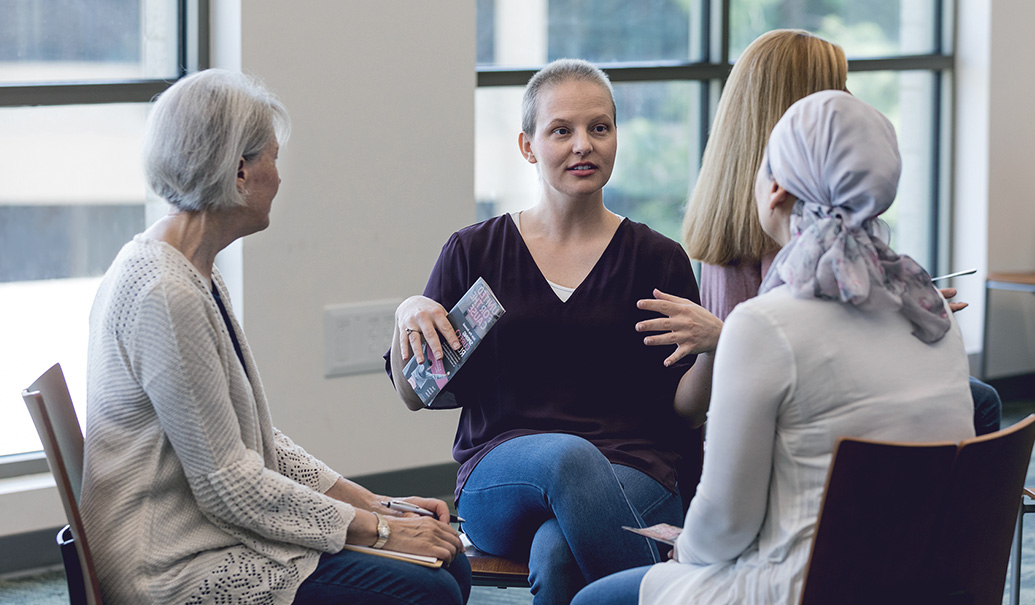Cell and gene therapies (C>s) are a result of the most innovative medical research and scientific progress in medicine today. These therapies offer hope and the possibility of healthier lives for thousands of patients struggling with debilitating conditions such as spinal muscular atrophy (SMA) and multiple myeloma. And yet, for the few that have been through the C> treatment process, the experience is an obstacle course filled with potential setbacks. The journey from symptom onset to diagnosis and treatment is a race against time that often leaves patients with gaps in understanding of their condition and the treatment process, which can have serious consequences.
ZS study find opportunities for C> patient engagement
Over the course of 2022, ZS mapped the experiences and perceptions of over 100 current and prospective C> patients, caregivers and members of patient advocacy groups (PAGs). Our research spans across 20 countries in North America, Europe, the Middle East, Africa and the Asia-Pacific region, and was part of an immersive initiative that fundamentally changed the way we see the C> space. Through these incredibly eye-opening and candid conversations, our team captured the intangible but influential psychosocial and environmental drivers that determine a patient’s ability to understand, process and undergo C>s. We also gained a better understanding of where pharma can intervene to improve the patient experience. Finally, we brainstormed with our patients and PAGs about how pharma can better engage to change the paradigm for patients and stakeholders.
As C>s expand into new and competitive therapy areas (TAs), the patient voice will play an increasingly important role in treatment decisions, and patient engagement will emerge as part of the last-mile effort to helping patients realize the full benefit of treatment. If the industry can strategically embed a patient-first focus into C> launch planning today, it could prove to be a valuable investment in a C> asset’s future. The results of our study shed light on the nuances of the C> patient experience and can help the industry think about engagement in a new way.
Current C> engagement efforts don’t meet patient expectations
The patient and caregiver’s story: “CAR-T [therapy] saved my daughter’s life. She has been in remission for many years. But we have post-traumatic stress disorder—there was no support for parents. My wife and I look at each other at 3 a.m. and know why we are awake. It is the nightmares of the ICU.”—Father of a pediatric chimeric antigen receptor T-cell (CAR-T) patient.
Although patient engagement has demonstrated significant value in multiple TAs, it is nascent in the C> space. There are many reasons for this. For example, companies often prioritize activities around the innovative science and operations that make C> treatments available on a global scale. But is this enough to ensure that these transformational therapies are available to patients? According to the patients in our study, the answer is no.
All patients and caregivers agree with the transformative impact of C>s on their lives. Yet, every single patient or caregiver story we heard sounded like marathon with many hurdles, unforeseen bumps and challenges. There was limited support in sight. We found 70% of these patients did not receive any support from manufacturers, along what is a multifaceted and complex journey. Only 10% of C> patients found the pharma-led support they received to be valuable, with a meaningful impact on their experience.
70% of C> patients did not receive any support from manufacturers. Only 10% found the pharma-led support they received to have a positive impact on their experience.
According to our study, lackluster support and the absence of impactful engagement has negative consequences, including high levels of ongoing distress (70%), feelings of post-infusion abandonment (50%) and even delays in treatment decisions (30%). As devastating as these outcomes are to patients, they also place a heavy burden on healthcare systems.
However, through our conversations with patients and caregivers we’ve identified three actions that pharma can take to improve current, short- and long-term patient engagement efforts.
Action 1: Create greater awareness of C> patient solutions
The patient’s story: Jeanette received a CAR-T for multiple myeloma in the U.S. and shared her experience of having to travel to another state to receive the therapy. The logistical challenges of ensuring that the timelines and arrangements were in sync, compounded with the emotional burden of having cancer, took a toll on her. Because Jeanette struggles to use the internet and her doctor, based in a small local hospital, was unaware, she was not able to benefit from pharma-led travel assistance for her specific treatment.
Of the patients we spoke to who received C>, 80% were unaware of the existence of such services in markets where they’re available in the U.S., Canada, China and Australia. Every patient we talked to described a desire for at least some engagement to ease their burden throughout the treatment journey.
These findings underpin the importance of consistent socialization of patient services, a key part of which is conveying the value proposition to healthcare professionals (HCPs). HCPs are a key channel for patient enrollment in the U.S., and the only channel available to patients in other markets. HCPs also need to be empowered with messaging and tools to effectively convey the availability of relevant services to patients. Solutions also need to incorporate seamless enrollment mechanisms and handover from clinics to patient service teams. With C>s, knowledge of the therapy and services is concentrated in a few centers of excellence (COEs), which means patients frequently struggle to find the support they need beyond those centers. In the absence of promotion, patients may never find that knowledge or those resources.
Action 2: Design customizable programs for evolving, complex patient needs
The patient’s story: Rodica, a multiple myeloma patient who received CAR-T therapy in the U.K., told us that when she received a brochure outlining the process and treatment, she cast it aside. She felt intimidated by and uncomfortable with the scientific language. She instead relied on a local PAG’s Facebook group to get information because she didn’t just want to learn about the therapy—she wanted to understand the impact it would have on her life. This kind of information is best conveyed through peer-to-peer interactions.
As bespoke as C>s are, the limited patient offerings built around them, which are designed for all patients, are insufficient for most. Existing solutions fall short because the information isn’t reaching patients. When it does reach them, the format can be hard to process. Patients may find the information don’t resonate or feel credible to them, which is a sentiment often shared by their HCPs.
C> patients with the same disease, who are on the same treatment, can have vastly different experiences based on myriad factors, such as location, local infrastructure, culture, personal preferences, education levels and varying relationships with the healthcare system and within their homes.
Our research identified three key considerations manufacturers should take into account when thinking about C> patient engagement:
- A patient’s degree of health literacy and their ability to obtain, process and assimilate new and complex information
- The presence of a consistent personal support network to help patients manage the logistical, financial and emotional elements of treatment
- Self-empowerment and the extent to which an individual has the wherewithal to proactively advocate for themselves
For each of these considerations, every patient falls at different points across the spectrum. This means that a solution that is table stakes for one patient’s success with C> may not be as relevant for others. We need to meet patients where they are. That requires factoring these considerations into the strategy and design of patient engagement and support solutions.
Action 3: Build solutions for the entire journey, not just treatment
The patient’s story: Margoth’s child received a gene therapy for a neuromuscular disorder in the U.S. and was assigned a coordinator from the manufacturer to ease the insurance and logistics navigation. While this was immensely helpful, Margoth craved a connection with a family who had been through the process, to hear how they managed the anxiety around what to expect, from preparing for treatment to dealing with adverse events. Psychological support was critical but remained unaddressed throughout her family’s journey.
Of the 30% of C> patients who received some form of pharma-led support, 80% said that the support they received was focused on receiving the treatment, such as therapy education and logistics assistance. Nearly all our patients wanted to talk with individuals who experienced C> and could speak to its impact on their life, while providing assurance and credibility. But solutions built to meet this need are few and far between. While manufacturers focus on this one part of the patient journey, the reality is that the perilous road for C> patients is unending and uncertain, before, during and after treatment.
Many aspects of the C> treatment journey depend on the TA and the patient’s location. For example, the diagnostic burden is heavier for babies with SMA born in markets where newborn bloodspot screening (NBS) is not available, such as in the EU and many Asian markets. In Australia, a recently piloted NBS program expedites diagnoses in some parts of the country, but the travel and logistical burden for caregivers in rural areas remains high, given the need to travel to COEs concentrated in the cities for long periods of time. With diseases like SMA, where time is neurons, patients and their loved ones pay a lifelong price for the absence of solutions that could ease their journey.
At each stage of the process, from pre-diagnosis and treatment to long-term follow-ups, patients experience numerous and compounded emotional, logistical and psychosocial hurdles, all of which influence the extent to which patients will benefit from C> over time. Therefore, we believe pharma needs a better and broader understanding of what patients go through before, during and after treatment to fill the gaps with more high-impact solutions.
The future of CGT patient engagement
When we spoke to patients who may receive a C> in the future, we found a unanimous expectation for solutions customized to meet them where they are. Intentional and meaningful patient engagement will play an increasingly important role in C> treatment. As C>s enter chronic condition TAs and an increasingly competitive landscape, patient needs will change. Patients and HCPs will expect more from manufacturers than just the provision of innovative treatment. As patient experience starts to drive treatment choice, manufacturers must build robust and relevant solutions that support patients at key moments during their journey, and adapt to their evolving needs, to realize the full benefit of C>’s life-changing potential.
Add insights to your inbox
We’ll send you content you’ll want to read – and put to use.
















